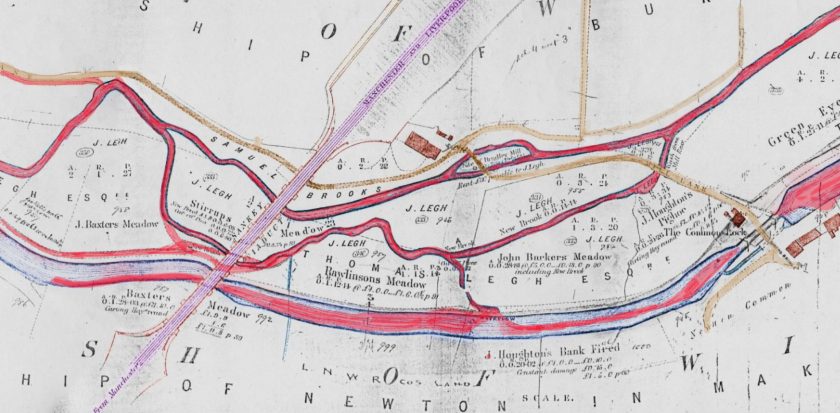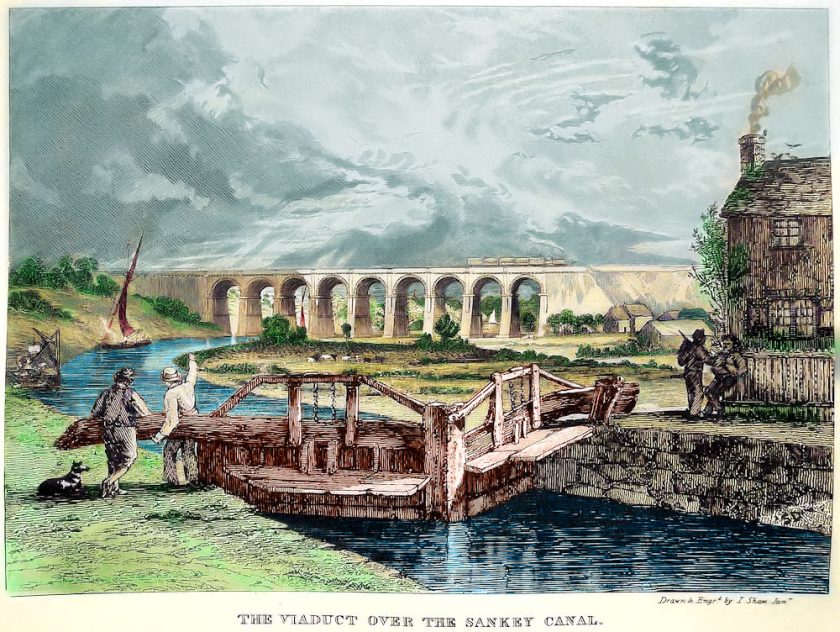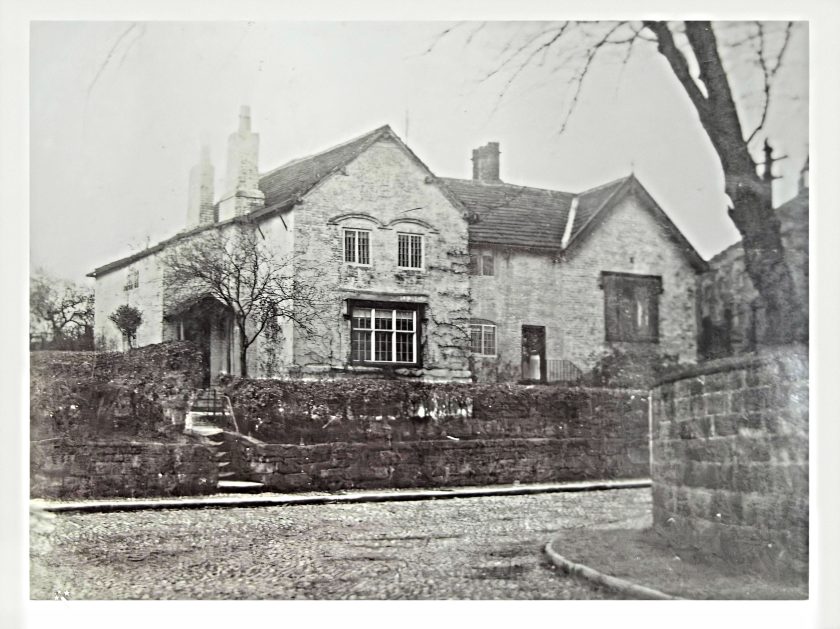Underhanded Dealings in the Construction of the Sankey Canal: A Study of Henry Berry’s Secrecy
The Sankey Canal, often recognized as the first true canal of the Industrial Revolution in England, marks a pivotal shift in the country’s transport and industrial infrastructure. Under the direction of Henry Berry, its construction not only facilitated the efficient movement of coal but also set precedents in engineering and legislative interaction. This expanded essay which is built upon T.C Barker’s 1948 thesis, explores the detailed construction timeline, legislative framework, and broader impacts of the canal.
Construction of the Sankey Canal began in 1755, following the passing of the initial Act of Parliament. This Act, approved on March 20, 1755, was officially titled “An Act for making navigable the River or Brook called Sankey Brook and for cleansing, preserving, and keeping the same in repair.” It authorized the improvement of the Sankey Brook from the River Mersey at Sankey Bridges up to a point near St. Helens.
Before you get any further with my ramblings, and so that you understand what I am referring to, you should probably read ..
T.C. Barkers 1948 Thesis concerning the building of the Sankey Navigation / Sankey Canal
Henry Berry’s Ingenious Yet Secretive Approach
Henry Berry, appointed as the chief engineer for the Sankey Canal, embarked on a far more ambitious project than the initial legislative mandate of merely making the Sankey Brook navigable. His vision for constructing a full canal involved significant engineering feats, including the creation of locks and an aqueduct to manage the elevation changes along the canal’s route. This bold undertaking was kept somewhat secretive, likely to manage investor expectations and mitigate resistance from local landowners. Berry’s involvement in the project is a quintessential example of early industrial engineering intertwined with strategic management and secrecy. His role went beyond technical engineering; it encompassed the adept handling of stakeholder expectations under the cover of strategic secrecy, showcasing his ability to navigate complex challenges while pushing the boundaries of traditional infrastructure projects.
Vision Beyond the Mandate
Initially, the Act of Parliament authorized improvements to the Sankey Brook to enhance its navigability. However, Berry recognized the limitations of simply dredging the brook and proposed a more radical transformation—converting it into a full-fledged canal. This vision was not just about enhancing the existing waterway but creating a new, more efficient, and reliable transportation route to support the burgeoning industrial demands, particularly for coal transportation.
Strategic Secrecy and Management
Understanding the potential backlash from investors and local landowners wary of the risks and scale of a new canal project, Berry adopted a secretive approach. The T.C. Barker thesis suggests that Berry’s decision to construct a full canal was kept under wraps to prevent any premature alarm that might jeopardize funding or provoke opposition from those who would be most affected by the extensive construction works.
This approach allowed Berry to progress with the construction while gradually acclimating stakeholders to the reality of the project’s scope. It was a calculated risk, balancing the need for transparency with the potential for disruption that full disclosure might have caused.
Key dates, names, and places chronologically:
Key Dates and Associated Events:
1563-1567: Exeter waterway constructed with early lock system
1623: Adam Martindale born at Moss Bank (mentions coal pits in early recollections)
1700: Thomas Steers possibly worked on Rotherhithe Dock
1709-1715: Thomas Steers constructs first Liverpool dock
1713: William Clayton’s will mentions Parr Hall
1719: Henry Berry born
1724: John Berry of Parr mentioned as trustee of Independent Chapel
1726: Liverpool to Prescot Turnpike established
1732: Weaver Navigation opened
1736-1741: Thomas Steers advises Newry Navigation Commission
1750: Death of Thomas Steers; Henry Berry becomes acting dock engineer
1751: Berry officially appointed as Liverpool’s Dock Engineer
1753: Second Liverpool dock (Salthouse) opened
1754:
June 5: Liverpool Council orders survey of Sankey Brook
October: Council resolves to lend £300 for Parliamentary expenses
December: Petition referred to House of Commons
1755:
March 20: Sankey Navigation Act passed
September 5: Work begins on canal
1757: November: Canal opens to Haydock and Parr collieries
1759: Survey shows canal completed to Gerard’s Bridge
1761: First dividend paid to shareholders
1762: Second Act allows extension to Fidler’s Ferry
1773: British Cast Plate Glass Manufacturers establish at St. Helens
1774: Leeds and Liverpool canal reaches Liverpool
1778: Sarah Clayton’s coal business sold
1812: Death of Henry Berry
1830: Canal extended to Widnes
1931: Northern section above Newton Common Lock closed
Key People:
Engineers/Surveyors:
Thomas Steers – First Liverpool Dock Engineer
Henry Berry (1719-1812) – Second Dock Engineer, Sankey Canal engineer
William Taylor – Co-surveyor with Berry
John Eyes – Later surveyor
Businesspeople/Promoters:
Sarah Clayton – Lady of Manor in Parr, coal mine owner
John Blackburne Jr. – Liverpool saltworks owner
John Ashton – Major financier of the canal
Local Officials:
James Crosbie – Liverpool Mayor
Charles Goore – Later Liverpool Mayor
Richard Trafford – Mayor’s Bailiff
Key Places:
Canal Locations:
Sankey Brook/Navigation, Sankey Bridges, Gerard’s Bridge, Penny Bridge, Fidler’s Ferry, Newton Common Lock
Towns/Areas:
Liverpool, St. Helens, Parr, Prescot, Warrington, Whiston, Windle, Sutton
The Three Acts of Parliament
The Act of 1755: As previously mentioned, this act initiated the formal legal foundation for making the Sankey Brook navigable. It provided the necessary legislative support to begin the extensive civil works that would transform the brook into a functional waterway.
The Act of 1762: Recognizing the need to extend the navigation capabilities and to manage water levels more effectively, a second act was passed. This legislation allowed for the extension of the canal to Fiddler’s Ferry, enhancing the canal’s utility and addressing some of the initial limitations in the original plan.
The Act of 1772: This act was instrumental in further expanding the canal, particularly to facilitate the burgeoning industries around St. Helens. It allowed for more significant modifications and improvements, reflecting the canal’s critical role in supporting regional industrial growth.
T.C. Barker’s thesis points to several key pieces of evidence for Henry Berry’s “secret plan”:
The Act’s title itself was misleading: “An Act for making navigable the River or Brook called Sankey Brook” – There was no mention of building a complete canal.
Barker quotes Berry’s obituary notice which stated that “after an attentive survey, he [Berry] found the measure [making the Brook navigable] impracticable and, knowing that the object they had in view could be answered by a canal, he communicated his sentiments to one of the proprietors who, approving the plan, the work was commenced on 5 September 1755, but the project was carefully concealed from the other proprietors, it being apprehended that so novel an undertaking would have met with their opposition.”
Barker suggests Berry had compelling reasons for this secrecy:
The increased risk of failure with a dead-water navigation might have deterred investors
Landowners might have opposed having their land covered with water
A similar project (Salford to Leigh and Wigan) had failed in Parliament just months before
Particularly interesting is Barker’s analysis of John Ashton’s role. He suggests Ashton was “almost certainly the proprietor to whom the obituary notice referred, and he stood by Berry on this critical decision.” This is supported by Ashton’s massive investment of 51 out of 120 shares, worth nearly £9,000.
Barker argues that while this might seem fraudulent, Berry used a clever legal loophole. The Act included a standard clause permitting “new cuts . . . as they shall think proper and requisite.” Berry apparently used this clause to justify building not fully an entirely new canal but more than if he had just been improving the brook.
Barker suggests Berry may have known right from the start that making the brook navigable was impractical, especially if, as Barker speculates, Berry grew up in Parr and knew the local conditions intimately.
Thus Henry Berry’s “secret” was maintained until after the Act was secured and shareholders were committed, at which point it was too late for opposition to form. While Barker presents this as somewhat duplicitous, he also seems to admire the strategic thinking behind it, noting that “There was everything to be said for secrecy and little for frankness until the act had been obtained and the shareholders had committed themselves.” This seems a fascinating example of early industrial ingenuity and perhaps necessary deception in the birth of Britain’s canal age. The success of the project ultimately validated Berry’s approach – the canal was completed and operational by November 1757, becoming what Barker argues was the first modern English canal, predating the more famous Bridgewater Canal.
Engineering Challenges and Innovations
The construction of the Sankey Canal presented numerous challenges, particularly related to water management and the terrain’s navigability. Berry’s innovative approach included the construction of several locks and an aqueduct to overcome these challenges. The notable feature of the canal was its independence from the natural river path, which involved extensive earthworks and the construction of infrastructure to maintain adequate water levels.
Impact on Industry and Transport
The completion of the Sankey Canal had a transformative impact on the local economy. It drastically reduced the cost and increased the reliability of coal transportation from the Lancashire coalfields to Liverpool, catalysing the growth of industries dependent on coal. Moreover, the canal spurred similar projects across Britain, heralding a wave of canal-building activities known as “canal mania.”
Barker mentions near the start of his thesis about Arthur Young’s “Six Months’ Tour Through the North of England” (1771) this is interesting because, as Barker points out, Young completely missed the significance of the Sankey Navigation despite crossing it on his journey. This supports barkers idea that under Berry’s leadership, the canal was built without much public fanfare.
The thesis references Mantoux’s “The Industrial Revolution in the Eighteenth Century,” which incorrectly states the Bridgewater was the first “real canal.” This misconception has been repeated by many historians, which Barker is attempting to correct, his issue with correcting, is always that the Parliamentary Act was for making the Sankey Navigable, not for making a Canal.
From the evidence presented by Barker in his references and notes, we can expand on Berry’s strategy..
Technical Innovation:
The thesis shows Berry used three key engineering features that Brindley later adopted for the Bridgewater Canal:
Clay-puddle to prevent water seepage
Sidelong ground construction techniques
Separation of brook and canal waters
Local Knowledge:
Barker provides strong evidence that Berry grew up in Parr through:
Trust Deeds at St. Helens Congregational Church
His will requesting burial there
Land tax records showing Berry family presence
Economic Context:
The thesis cites several factors that made the timing critical:
Rising coal prices at Prescot Hall Mine
Increased turnpike tolls
Growing Liverpool population needing more coal
Salt works requiring reliable coal supply
Legal Strategy:
Berry’s approach utilized:
Standard “new cuts” clause in navigation acts
Support from Liverpool Corporation
Strategic timing after Prescot toll increases
The effectiveness of Berry’s strategy is shown in Barker’s thesis through:
Completion in just over 2 years
Success in water management
Economic benefits to Liverpool and St. Helens
Influence on later canal development
The Sankey Navigation
It is widely recognized as Britain’s first industrial canal, though this fact is often overlooked in favour of the Bridgewater Canal.
The canal was approximately 10 miles long when completed.
It was built primarily to transport coal from the Lancashire coalfields to Liverpool and the growing chemical industries along the Mersey.
Key features included:
A system of nine locks
Multiple branches serving different industrial areas
Connection to the River Mersey
Industrial significance:
Served the early chemical industry in St Helens
Crucial for the development of glassmaking in the region
Important for the salt trade
Served Coal from St Helens area into Cheshire and Liverpool
Later history:
Became part of railway company ownership
Parts remained in commercial use into the 20th century
Sections still exist today though not navigable
Legacy:
Contributed to the industrial development of St Helens
Helped establish the viability of artificial navigation canals
Parts are now protected as industrial heritage
The T.C. Barker thesis argues compellingly that the “deception” employed by Henry Berry and a select few shareholders was perhaps necessary for technological progress, as complete transparency about the revolutionary nature of the project might have prevented it from receiving approval or investment. Berry’s secretive actions, within the context of the 18th-century industrial ventures fraught with uncertainties and high stakes, can be seen as strategic manoeuvres. The lack of precedent for such an extensive canal project likely justified, in Berry’s view, the need to shield the true nature of the works until the canal’s potential and progress were undeniable. This approach allowed Berry to navigate potential bureaucratic and financial obstacles that could have prematurely halted the project. Ultimately, while this secrecy facilitated the realization of a visionary canal project crucial for the region’s industrialization, it also introduced complex implications for project management practices, affecting stakeholder trust and shaping future industrial developments.
Positive Outcomes of the Secrecy
Realization of Visionary Infrastructure: Berry’s ability to extend beyond the limited goal of making Sankey Brook navigable allowed for the creation of a canal that was more capable of meeting the industrial demands of the time. This visionary project significantly boosted the region’s economy by providing a reliable and efficient means of transporting coal and other goods, which was critical for the burgeoning industries in Liverpool and its hinterlands.
Avoidance of Early Opposition: By keeping the full scale of the project under wraps, Berry was able to prevent early resistance from investors and landowners who might have been reluctant to support a more ambitious and riskier venture. This strategy allowed construction to progress without significant delays that might have arisen from prolonged debates or legal challenges.
Possible Negative Outcomes of the Secrecy
Undermined Trust: Berry’s secretive approach might have had immediate project management benefits, but it potentially damaged the trust between him and the project’s stakeholders, including investors, landowners, and public officials. When stakeholders are unaware of the true scope and risks of a project, their eventual discovery of the reality can lead to a breakdown in trust, which is crucial for the success of any large-scale infrastructure endeavour.
Contentious Precedent for Project Management: The success of the Sankey Canal despite its secretive management might have set a dubious precedent for how other projects were managed. Future engineers and managers might view secrecy as a viable strategy to circumvent early opposition, potentially leading to ethical dilemmas and conflicts in the larger field of civil engineering and construction.
Risk of Financial and Legal Repercussions: While Berry’s project did not suffer from these consequences, his approach risked significant financial and legal implications had the project failed or had stakeholders chosen to litigate against the perceived deception. Such risks could jeopardize not only the project but also the financial stability and reputation of those involved.
Impact on Public Policy and Regulations: The Sankey Canal project could have influenced public policy regarding how future projects were regulated. Misalignments between project executions versus the approved plans might prompt stricter regulations and oversight procedures, potentially complicating the approval and management processes for subsequent infrastructure projects.
Conclusion
Henry Berry’s secretive strategy in the construction of the Sankey Canal underscores a complex interplay between visionary leadership and the ethical dimensions of project management. His management of this pioneering industrial project highlights how the ends often justified the means, even if it involved circumventing norms of transparency and stakeholder engagement. While the canal itself became a critical infrastructural achievement, the secretive methods of its realization raised significant considerations about transparency, trust, and the management of public resources. These lessons continue to inform best practices in project management, stakeholder engagement, and ethical leadership in engineering projects today. As we reflect on Berry’s legacy, it becomes evident that the Sankey Canal was not just a triumph of engineering but also a profound case study in the ethical considerations of industrial progress, illustrating the complexities and challenges of pioneering large-scale industrial enterprises.
Overview of T.C. Barker’s thesis on “The Sankey Navigation
T.C. Barker’s thesis, “The Sankey Navigation,” delivered in 1948, aims to redefine the historical significance of the Sankey Canal, asserting its precedence and importance over the more celebrated Bridgewater Canal. Barker argues that the Sankey Canal was not only the first true modern canal in England but also a pivotal development in the country’s industrial revolution, especially concerning transportation and coal distribution.
Key Arguments and Contributions
Historical Correction and Recognition:
Barker challenges the prevailing historical narrative that credits the Bridgewater Canal as the first of its kind in England. By delving into detailed historical records, Barker posits that the Sankey Canal, completed in 1757—four years before the Bridgewater—deserves this recognition. His argument is supported by extensive documentation, including acts of Parliament, contemporary accounts, and economic data showing the canal’s early use and impact.
Economic Impact:
The thesis highlights the Sankey Canal’s role in facilitating the coal supply essential for Liverpool’s growth and the burgeoning industries in North West England. Barker discusses how the canal alleviated coal shortages, reduced transportation costs, and supported local industries, which were crucial during a period of rapid urban and industrial expansion.
Engineering Innovations:
Barker sheds light on Henry Berry, the engineer behind the Sankey Canal, advocating for his recognition alongside contemporaries like James Brindley. He details Berry’s innovative approaches, such as constructing a fully navigable waterway independent of the existing river path, which involved significant engineering challenges and solutions, notably in water management.
Influence on Subsequent Canal Development:
The thesis discusses how the Sankey Canal’s success influenced subsequent canal projects across Britain, setting technical and operational precedents that shaped future developments in inland waterway navigation.
Source of Technological and Industrial Inspiration:
Barker argues that the canal was a critical infrastructural element that not only supported the local economy but also inspired further technological advancements in canal engineering. He suggests that the experiences and solutions from the Sankey Canal were likely known to and influenced James Brindley, linking it to the broader narrative of British engineering achievements during the industrial revolution.
Critical Analysis
Barker’s thesis is meticulous in its historical research, drawing from a variety of primary sources to construct a compelling argument for the Sankey Canal’s precedence and impact. However, his claims, while well-supported, could benefit from a broader analysis of the socio-economic conditions of the period, which might provide deeper insights into the canal’s transformative effects on local communities and industries beyond the coal trade.
Conclusion
T.C. Barker’s “The Sankey Navigation” is a significant scholarly work that contributes to our understanding of early industrial advancements in England. It not only corrects a historical oversight but also celebrates the ingenuity and impact of early engineering works on the industrial landscape of Britain. Barker’s advocacy for Henry Berry’s recognition adds a layer of depth to the study, emphasizing the human element in these monumental engineering achievements.
This text @Steven dowd, 2025 represents some of my thoughts on T.C. Barkers Thesis and also some of my findings while reading about the construction and beginnings of the Sankey Navigation



